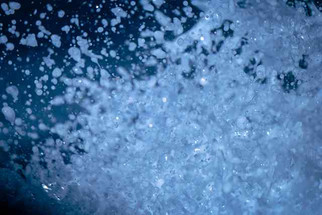Female Ejaculation Explained: Squirting 101
Female ejaculation, or ‘squirting’, or ‘gushing’ has been the subject of much medical research and discourse over the past several decades, and the phenomenon itself has been documented for thousands of years by every culture in the world. Studies have been carried out under various hypotheses to determine whether the fluid may actually be urine escaping due to ‘stress’ on the urethra during sex, or whether it’s simply pre-sex lubrication fluids coming out in a spurt after orgasm. As any “shejaculator” will tell you, it’s neither.
How Does It Work?
The original source of the clear fluid remains somewhat of a mystery, but it emerges from the Skene’s glands, which are located in the spongy tissue that surrounds the urethra, otherwise known as the G-spot. This tissue is located about two inches inside the vagina against the front wall - you can feel it easily with your fingers. When stimulated, the G-spot (named for the German gynecologist Ernst Gräfenberg who discovered it) can deliver a high state of sexual arousal ending in powerful ‘vaginal’ orgasms.
The fluid exits the Skene’s gland through Skene’s ducts which are located on either side of the urethra, and reach the skin’s outer surface. The ‘urethral sponge’ becomes engorged with blood during sexual arousal, which compresses the urethra making it less likely that a woman will urinate during sex. The pubococcygeus muscle also keeps urination at bay, so if a woman has a weak pubococcygeus muscle, it is possible that urine will also come out during ejaculation. Clinical studies have shown at least a small presence of urine in some ejaculate.
The Missing Link
Australian urologist Dr. Helen O'Connell discovered a connection between the clitoris and the G-spot that is perhaps the ‘missing link’ in the mystery of the clitoral orgasm versus the ‘vaginal’ orgasm. It appears that the spongy tissue which houses the Skene’s glands, also houses the nerve endings from the clitoris. So it would seem that the two pleasure centers are connected.
G-Spot Tips
Because the G-spot is approximately one centimeter underneath the surface of the skin, firm pressure against the ‘spot’ is required to elicit its full arousal. The amount of ejaculate to emerge at orgasm varies widely, from a teaspoon to a pint. Many anecdotal stories end in advice to have a towel handy if you’re planning to experiment!
Not all sexual positions will activate the G-spot. If you want to experiment, try manual stimulation or invest in a G-spot specific sex toy that is angled for this purpose. Sex experts suggest emptying the bladder beforehand since the sensations are very similar and could be confusing or irritating with a full bladder. Remember to apply firm pressure, and don’t be alarmed if the spongy tissue hardens – it’s just becoming swollen with blood.
Our resident sexpert, Dr. Ava Cadell:
Female ejaculation has been documented in ancient Asia for many thousands of years. Here in the Western world scientists are finally accepting it as a reality and women of all ages are enjoying the experience of ejaculating during orgasm. I believe that every woman can ejaculate if she is stimulated correctly and if she knows how to control her PC muscles. It’s estimated that less than 10% if women ejaculate, or at least admit to it. In Tantra, female ejaculation is called, Amrita which means, Nectar of the Gods. Some women who experience ejaculation admit that the feeling is like an intense orgasmic release, much stronger and longer than a clitoral orgasm. Female ejaculation can be attained with stimulation of the G-spot, the spongy area located inside the yoni about two inches on the upper wall towards the navel. Always empty your bladder first so that the ejaculation doesn’t have any urine in it. The ejaculate fluid is protein based, much like semen, but it’s thinner and of course it doesn’t have any sperm. In summary, female ejaculation is a normal natural occurrence, so why not try it? You might like it!

